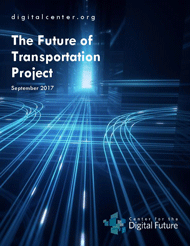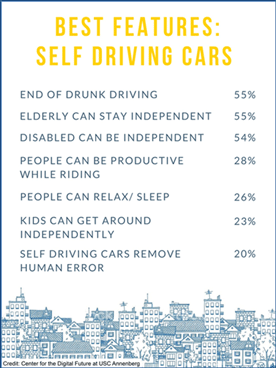The Future of Transportation Project
 The Center has unveiled a first-of-its-kind study on the future of transportation — a project that explores the spectrum of American behavior and views about their cars, public transit, reasons to give up driving, new competitors in the automobile industry, distracted driving, and the arrival of self-driving cars.
The Center has unveiled a first-of-its-kind study on the future of transportation — a project that explores the spectrum of American behavior and views about their cars, public transit, reasons to give up driving, new competitors in the automobile industry, distracted driving, and the arrival of self-driving cars.
“Most research covers the transportation revolution from an industry perspective, but our study focuses on the behavior and attitudes of the U.S. population,” said Dr. Brad Berens, chief strategy officer for the center and project lead for the Future of Transportation Study.
“Automotive research typically looks at car buyers; we are just as interested in Americans who don’t have their own cars or who are thinking about giving up their cars,” Berens said.
Provocative, Sometimes Counter-Intuitive Results
The data from the project has yielded fascinating and often surprising results. American enthusiasm for simply getting into a self-driving car was high, with 38% of Americans open to the idea. Other data from the Center suggests that this percentage is increasing year over year, particularly among younger Americans.
 Beyond the basics of getting around, the Center also explored the likely impact of autonomous vehicles on other industries, like hospitality. A striking 25% of Americans would choose to sleep in a self-driving car with a bed rather than use a conventional hotel, with percentages leaping much higher for younger between 18 and 35 years of age. This is potentially both an opportunity and a challenge to American hotels. Discussion of this and adjacent results can be found in the Center’s regular columns, including “Can self-driving cars save local businesses?” and “Uber’s accident won’t stop self-driving cars for long.”
Beyond the basics of getting around, the Center also explored the likely impact of autonomous vehicles on other industries, like hospitality. A striking 25% of Americans would choose to sleep in a self-driving car with a bed rather than use a conventional hotel, with percentages leaping much higher for younger between 18 and 35 years of age. This is potentially both an opportunity and a challenge to American hotels. Discussion of this and adjacent results can be found in the Center’s regular columns, including “Can self-driving cars save local businesses?” and “Uber’s accident won’t stop self-driving cars for long.”
In addition to a national perspective, the Center team has also sliced the data by age, income, region, gender, politics and more. For example, although at a national level 86% of Americans would not consider giving up driving, as seen in this Web Insight those percentages vary by region.
The Future of Transportation Project explores more than 100 issues involving behavior and views about cars, their alternatives, and emerging needs for technology, including:
-
- Reasons why Americans would give up driving
- Interest in self-driving cars as alternatives to driving
- Use of Get-a-Ride Services or “GARS” (such as Uber or Lyft) and alternative-access programs such as ZipCar or Car2Go
- Distracted driving
- Views about digital technology in cars
- Internet connectivity while driving
- Future car technology
- Views about technology companies such as Google or Apple entering the car business
For more information or to schedule a briefing, please contact Brad Berens via email at [email protected] or by phone at (310) 651-6976.
The Future of Transportation Study included 1,000 participants drawn from a representative national sample, and has a margin of error of +/- 3.0 percent.
New industry-specific studies by the Center
The Future of Transportation Project is the first of a series of new initiatives by the Center for the Digital Future that focus on industries that are dependent on evolving digital technology. The center’s research on transportation was followed by a study on banking, and it will be followed by a study on health in 2019.
“These reports expand on the center’s 17 years of unique work on the impact of digital technology on American life,” said Jeffrey I. Cole, founder and director of the center for the Digital Future. “The results reveal the current behavior and views of Americans, which serves both as a reality check on the worldview constructed by the media, and also as a source of insight and inspiration that companies can use for their planning.”
The Center for the Digital Future
Since 1999, the Center for the Digital Future (www.digitalcenter.org) in the USC Annenberg School for Communication and Journalism has examined the behavior and views of a national sample of internet users and non-users in major annual surveys of the impact of the digital technology on America.
The center’s Digital Future Project is the longest continuing research of its kind, and was the first to develop a longitudinal panel study of the views and behavior of internet users and non-users in the United States. The center also created and organizes the World Internet Project, which includes similar research with 32 international partners.
__________

